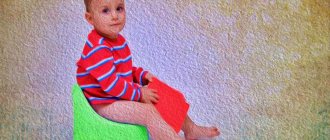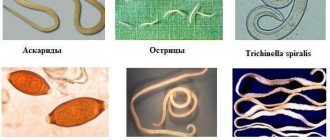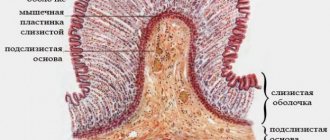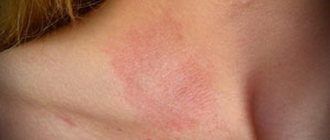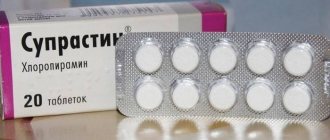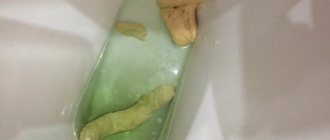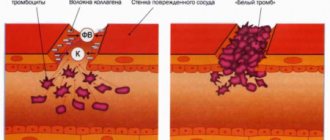Giardiasis is a disease that occurs when single-celled protozoa Giardia enters the human body. Giardia is a cell whose structure resembles a pear. At one end it has 4 pairs of flagella (organelles of movement) and a suction cup, allowing it to firmly adhere to the intestinal epithelium.
Giardia reproduces by division. The division process lasts 5–20 minutes, so for the development of the disease, it is enough for 1–10 protozoan cysts to enter the body, and after a short time there are many more of them. Giardia can be detected in a child or adult through symptoms or laboratory tests.
What to do in such a situation? To get started, we recommend reading this article. This article describes in detail methods of controlling parasites. We also recommend that you consult a specialist. Read the article >>>
This is what Giardia looks like
Treatment of giardiasis in adults
Treatment of giardiasis in adults, the treatment regimen involves three stages:
- cleansing the body of toxins and waste products of parasites;
- taking antiparasitic medications;
- restoration, strengthening of immunity.
Preparatory stage
At the first stage, the patient is prescribed a diet and taking choleretic, antihistamines, and enterosorbents. Such actions help stop the proliferation of Giardia, reduce their number, improve the functioning of the stomach and intestines, and also help cleanse the body of toxins produced by pests. Preparatory measures are necessary to achieve a good result in treatment and minimize side effects.
If a patient's giardiasis is accompanied by a disorder in the functioning of the gastrointestinal tract, it is impossible to immediately begin to destroy parasites, since the simultaneous death of a large number of parasites will lead to intoxication of the body. This can significantly worsen the patient's condition.
The duration of this period depends on the degree of intoxication, in general it takes from one week to a month. The diet for giardiasis in adults involves the use of Pevzner's table No. 5 with some difference - a more significant restriction of carbohydrates. The main principles of this diet include:
- limit carbohydrates and lactose in the diet;
- eat more proteins;
- fractional meals (about five to six times a day with an interval of four hours);
- consume at least 20 g of dietary fiber per day (eg bran).
What not to eat:
- margarine;
- salo;
- fatty meats;
- rich broth;
- all types of legumes;
- mushrooms;
- smoked;
- pepper, other hot seasonings;
- pure eggs;
- sweets, carbonated drinks.
Recommended food:
- buckwheat, oatmeal, rice, egg, wheat porridge;
- lean fish;
- lean meat;
- light soup with butter;
- fruits;
- boiled vegetables;
- fermented milk products;
- Sweets include honey, marshmallows, and marmalade in small quantities.
Smecta and Enterosgel are well suited as enterosorbents. They help remove toxins, protect the mucous membrane from the negative effects of parasites, and create favorable conditions for the development of beneficial bacteria. Smecta can be consumed even during pregnancy
To cleanse toxins, it is important to avoid constipation; Duphalac will help with this.
Getting rid of Giardia
The second stage involves the patient taking antiparasitic drugs. The most widely used in this area are:
- Metronidazole;
- McMiror;
- Nemozol;
- Ornidazole;
- Tinidazole;
- Albendazole;
- Furazolidone.
Under no circumstances should you resort to self-medication. The required drug should be prescribed exclusively by a doctor. In this case, concomitant diseases, contraindications, and a history of allergies are taken into account. In parallel with antiparasitic medications, the patient continues to take medications that help remove toxins from the body. Many experts, along with taking anti-giardiasis medications, recommend taking Wobenzym, which has an effective anti-inflammatory, analgesic, decongestant, and immunomodulatory effect.
Recovery stage
At the end of the treatment process, it is necessary to restore the normal functioning of the digestive tract. After all, during the entire stay of Giardia in the body, the intestinal mucosa has been subjected to aggressive lesions, other organs are depleted of toxins, and the process of digestion and metabolism is disrupted. The body's protective functions are significantly reduced.
In order to restore the body after getting rid of lamblia, it is necessary to saturate it with vitamins and beneficial microelements (vitamins A, B, C, D, zinc, manganese, chromium, iodine, calcium, etc.). Drugs such as Stimbifide and Bion 3 help with this. To strengthen the immune system, the doctor may prescribe immunomodulators.
It is useful to follow a diet throughout the course of treatment. If giardiasis is accompanied by allergic reactions, it is also necessary to take antihistamines. Patients often note that after getting rid of parasites, they experience seasonal allergies. To avoid re-infection with parasites, you must adhere to the following basic rules:
- maintaining personal hygiene;
- eat only washed fruits;
- drink exclusively boiled or bottled water;
- wash your hands after contact with animals;
- prevent flies from getting on food;
- do not swim in polluted waters.
These simple rules will help protect yourself and your children from giardiasis.
Treatment
Treatment consists of a long period of taking medications. As a rule, they prescribe:
- Tinidazole is a drug that has an antibacterial effect and is used to treat worms. The course of treatment is no more than 2 days. Contraindications include disorders of the central nervous system and pregnancy.
- Tiberal is an antimicrobial drug that is most effective among its analogues on the market. For a one-day course of administration, its effectiveness is 95%. The medication has no contraindications.
https://youtu.be/dCY3OVq8qaE
Symptoms of giardiasis
The incubation period lasts from several days to a month or more. Most often, the disease does not cause any clinical manifestations at all, especially in adults.
Basically, in children, the onset of the disease can begin with the appearance of low-grade or febrile temperature (37.1–38.0°C or 38.0–39.0°C), abdominal pain, nausea, sometimes vomiting, flatulence, and loose stools. The abdomen is painful, swollen, and growls along the intestines. Infants become restless, scream, sleep is disturbed, symptoms intensify during and after feeding, allergic dermatoses and diaper rash may appear. Over time, if left untreated, this can lead to impaired growth and psycho-emotional development, frequent colds or allergies, and the development of chronic problems of the gastrointestinal tract.
In children of later age and adults, such vivid symptoms are rarely observed - the gradual development of dyspeptic symptoms from the gastrointestinal tract of a moderate nature comes to the fore:
- flatulence;
- discomfort and pain in the abdomen, mainly in the umbilical region and right hypochondrium;
- stool disorders in various combinations;
- the appearance of plaque on the tongue;
- sometimes bitterness in the mouth and skin manifestations (increased severity of acne, chronic polyetiological diseases, for example, psoriasis and dermatitis);
- Possible autonomic disorders, headaches, dizziness, instability of blood pressure, increased body temperature, sensitivity of the lymph nodes.
In general, during the course of giardiasis, the following main symptom complexes can be distinguished:
- Symptoms of intoxication and autonomic changes are increased fatigue, tearfulness, irritability, sleep disturbances, dizziness, arrhythmias, low-grade fever and others.
- Symptoms of gastrointestinal tract damage are discomfort and pain of varying intensity and character in various parts of the abdomen, nausea, loss of appetite, a feeling of bitterness in the mouth, stool disorders (constipation and diarrhea), coating on the tongue and bad breath, weight loss and more.
- Symptoms of skin damage are allergic rashes of various nature and localization, atopic dermatitis, pallor and roughness of the skin, increased dryness of the skin, cheilitis (inflammatory changes in the skin of the lips and their mucous membranes), seizures (cracks in the corners of the mouth), atypical/uncontrolled course of chronic skin pathologies.
- Increased development and exacerbation of diseases not directly related to giardiasis - bronchial asthma, pseudo-allergic phenomena, gastritis, stomach and duodenal ulcers, cholecystitis, ulcerative colitis, arthritis and more.
- Symptoms of malabsorption (loss of nutrients) are vitamin deficiencies, retardation in physical and mental development, dystrophy (these manifestations are more typical for children).
Giardiasis in pregnant women does not have any specific differences from giardiasis in other people, but can lead to an increased risk of developing B-12 deficiency anemia and decreased fetal weight (hypotrophy) in a pregnant woman.
Manifestations of chronic giardiasis
Sometimes protozoal infection occurs without an acute stage. This is due to the fact that parasites have learned to shed immunity factors (antigens) that fight them.
Chronic giardiasis is accompanied by nausea and vomiting
More often, the disease begins in the acute phase, but in the absence of quality therapy, after 4–12 weeks it becomes chronic. That is, chronic giardiasis occurs as a result of prolonged parasitism of pathogenic microorganisms in the small intestine. Then the following changes appear in the body:
- Digestive disorders, absorption of lactose, vitamins, micro- and macroelements, proteins, lipids, carbohydrates. This is due to the fact that Giardia repeatedly damages the inner lining of the jejunum. As a result, the mucous membrane does not have time to renew itself and immature cells are formed that cannot produce certain enzymes.
- Allergic reactions, dysfunction of the central nervous system, as well as the liver. These conditions arise due to increased permeability of the inner lining of the jejunum and the penetration of toxins (harmful substances released by living or dead individuals) into the bloodstream.
- Pain occurs as a result of irritation of receptors in the jejunum.
- Giardia suppresses the immune system.
With the prolonged presence of Giardia in the body, pain appears on the right under the ribs, around the navel or along the entire front wall of the abdomen. Many patients complain of girdling pain, the intensity of which ranges from mild aching to sharp and paroxysmal.
In addition, stool disorders are observed when diarrhea alternates with constipation. As a rule, feces are greasy, have a characteristic shine, and are difficult to flush from the toilet.
An adult may experience flatulence, nausea, vomiting, and decreased appetite. Younger patients experience bruxism (teeth grinding) at night. This symptom occurs when there is a large number of Giardia in the jejunum, which are activated at night.
With chronic giardiasis, allergies develop:
- blisters, spots on the skin;
- itching in areas of the rash;
- inflammatory damage to the edges of the eyelids;
- food allergies;
- runny nose of allergic origin;
- atopic dermatitis;
- asthma, etc.
Children develop more slowly physically due to frequent digestive disorders, as well as impaired absorption of nutrients.
Treatment of giardiasis in adults
Treatment of Giardia in adults is carried out by an infectious disease specialist.
Before deciding on therapy, the doctor must take into account such aspects as:
- The severity of the symptoms of the disease;
- Duration of presence of Giardia in the intestines;
- Presence of concomitant diseases.
It is equally important to try to determine the source of the invasion in order to prevent reinfection. Treatment should not be started by taking antiprotozoal drugs, as this will exacerbate the symptoms of the disease and may provoke a reactive response from the body.
Therefore, treatment of Giardia in adults is carried out in stages:
- Preparatory stage before treatment of giardiasis. At the preparatory stage, it is necessary to try to mechanically remove the maximum amount of Giardia from the intestines, as well as remove intoxication from the body. During this time, the patient must adhere to a dietary diet.
To do this, the patient must follow the following recommendations:
- Completely exclude sweets and carbohydrates from the menu, which are quickly absorbed;
- Eat foods rich in fiber;
- Eat protein foods;
- Avoid whole milk and limit fat intake;
- Eat according to a schedule, switch to fractional meals (5-6 times a day);
- Drink more fluids, giving preference to sour fruit drinks and choleretic decoctions.
- The use of antiparasitic drugs against Giardia. The second stage of antiparasitic therapy takes 5-10 days. All medications are prescribed by the attending physician, since almost all drugs have contraindications and side effects.
How to treat Giardia in adults - list of medications:
- Metronidazole (Trichopol) - dosage in adults is 0.4 g three times a day, vomiting, nausea, headache, sleep disturbances are possible.
- Albendazole - 0.4 g once for 5 days, possible development of liver failure, nausea and vomiting, hyperthermia.
- Fazizhin – one tablet 4 times a day for 2 days.
- Macmiror - 15 mg per kg of body weight, taken twice a day after meals for a week, possible manifestations of diarrhea, gastralgia, skin rash, nausea and bitterness in the mouth.
- Furazolidone is rarely used, since the drug is ineffective against modern strains of parasites.
Supplementing the diet is the intake of enterosorbents, choleretic drugs, antihistamines and digestive enzymes. In this way, conditions will be created in the intestines that are unfavorable for the proliferation of parasites and the rate of their division will be significantly reduced.
Drugs and dosages for the treatment of children are selected with special care, trying to minimize the toxic effect of drugs.
How to treat Giardia in children - medications:
- Flamin - 1/3 or 1/2 tablet three times a day, the course of treatment is designed for 10 days.
- Macmiror – used from 2 years of age at 15 mg per kg of child’s body weight, no more than 0.4 g in total. The course of treatment with 2 doses takes from 7 to 10 days.
- Intetrix - recommended for children from one year old, the therapeutic dose is ?-1-1? capsules three times a day.
Simultaneously with taking antiparasitic drugs, both adults and children take a course of antihistamines, enzymes and sorbents.
As a rule, the prognosis for giardiasis in adults is quite favorable. If the patient strictly follows all the doctor’s instructions, recovery is observed in 92-95% of cases. However, reinfection cannot be ruled out, so the patient should remain under clinical observation for another 3-6 months. During this time, it must be examined at least 2 times.
Antiparasitic treatment itself
Modern treatment regimens for giardiasis suggest using the following groups of drugs:
- nitrofurans (Furazolidone, Nifuratel);
- nitroimidazole group (Tinidazole, Ornidazole, Metronidazole);
- benzimidazole group (Albendazole).
The doctor decides what to treat and what specific drug to choose. Many drugs have quite serious side effects. All these drugs are contraindicated in pregnant women. The safest drug is Macmiror (active ingredient - nifuratel). The effectiveness of Metronidazole and Furazolidone in adult patients is not very high, so these medications are rarely used.
The duration of antiparasitic therapy is determined by the severity of clinical symptoms. Many drugs (Ornidazole, Tinidazole) are used no more than 1-2 times to achieve an effect. Nifuratel must be taken for at least 7 days in a row. Upon completion of this stage of treatment, one cannot yet be sure that giardiasis has been completely defeated. Most experts believe that it is necessary to undergo at least 2 courses of the antiparasitic stage of treatment (with drugs from various groups) in order to achieve complete destruction of parasites.
Step-by-step therapy of giardiasis
Measures cannot be started with the use of antiparasitic drugs. Against the background of a decrease in protective forces, additional intoxication due to chemicals in the blood increases the allergic manifestations of the disease. The severity of toxic-allergic complications and exacerbation of symptoms are cured in three phases.
Initial stage
It is necessary to eliminate intoxication, normalize the functioning of the immune system and intestines. Doctors recommend diet therapy. A typical menu for giardiasis includes vegetable oil, cereals, and dried fruits. Intestinal cleansing is achieved by taking enterosorbents and antiallergic medications. The duration of the stage is more than 2 weeks. Some infectious disease specialists recommend using plants to normalize bile secretion, such as immortelle and corn silk. At the pharmacy you can purchase a ready-made preparation consisting of plants - “Phebihol”. The drugs are used to reduce signs of intoxication.
Removal of protozoan waste products from the gastrointestinal tract is achieved by using polyphepane, enterosgel, and polysorb. Among antihistamines, Loratadine, Diazolin, and Cetrin are recommended. To improve digestion, enzymatic preparations are prescribed - “Mezim-Forte”, “Creon”, “Pancreatin”.
Second phase
It is rational to use antiparasitic drugs to inhibit the vital activity of protozoan parasites:
- “Albendazole” belongs to the category of the best drugs. Penetrates deeply into tissues, so it affects Giardia. Available in tablets of 400 mg per day. Treatment is prescribed for 5 days, then diagnostic tests are performed.
- “Ornidazole” – taken three times a day at a dose of 35 mg for 5 days. 15% of people experience weakness and dizziness while taking the medication.
- Tinidazole should not be prescribed to children under 5 years of age.
- “Niridazole” – 25 mg per kilogram of weight, taken for a week. Urine turns brown when the product is removed for 5 days.
- “Furazolidone” – you need to drink it for 7 days. Decreased appetite, vomiting and nausea - these symptoms are suppressed with medications. To eliminate additional symptoms, it is recommended to prescribe vitamins and antihistamines.
- “Metronidazole” - take 400 mg three times a day. This course is not always enough for an adult. If cysts are detected in the stool, repeated treatment with metronidazole is required for 5 days.
Antiparasitic treatment with drugs at the second stage for giardiasis will prevent chronic infection. For this purpose, you must carefully observe the dose and frequency of use of medications.
Third stage
It is recommended to take medications to strengthen the immune system. Diet therapy at this stage is aimed at improving gastrointestinal motility. The diet should include fermented milk products, baked apples, fruits and vegetables. To maintain immunity, medications are recommended - multivitamins, adaptogens, drugs to eliminate dysbacteriosis (probiotics). The duration of the phase is 2 weeks.
In the acute stage of giardiasis, one-stage treatment is carried out. For massive antiparasitic therapy, Metronidazole is used. Some infectious disease specialists recommend an alternative - Furazolidone. Of the modern anti-giardiasis drugs, Macmiror is recommended. The use of the drug is rational for giardiasis in women. The medication eliminates not only simple invasions, but also eliminates gynecological diseases and stomach ulcers. It is not recommended to take the drug on your own due to the high likelihood of side effects.
“Nemozol” is one of the strongest medicines with an effect against most parasitic diseases. There are tablets, syrups, and injections for the treatment of this infection. Taking medication is not enough, so symptomatic medications are recommended. There is no independent treatment for giardiasis. Only with careful adherence to the treatment regimen can parasites be destroyed and the chronic course of the disease prevented.
At the third stage, a special diet is recommended:
- vegetable purees;
- lean fish;
- lean meat;
- fermented milk drinks;
- greenery;
- baked apples;
- berry (lingonberry, cranberry);
- pearl barley, buckwheat porridge.
What happens during infection
Once in the body, lamblia is activated in the digestive system. Symptoms of the disease usually appear within two weeks or less after exposure. At that time, there are already many parasites in the body. Giardia is usually passed in the stool, but the body does not have enough time to completely get rid of it due to its high reproduction rate.
If the patient has poor gallbladder function or chronic liver disease, Giardia can penetrate the bile ducts, bladder and liver. This is a danger, especially if you have hepatitis or other liver diseases. Giardia in infected patients provokes the rapid development of existing diseases.
Diet for giardiasis
In the fight against the disease, it is necessary to exclude the following foods from the diet: whole milk, pasta, flour products, sweets, baked goods and sausages. The only cereals you can eat are buckwheat, corn and rice.
Milk must be replaced with yogurt or kefir. It is very useful for giardiasis to drink lingonberry or cranberry juice. Meat should be lean and boiled, and fruits and vegetables can be eaten in any quantity. It is not recommended to use mayonnaise as a dressing; it is better to use vegetable oil.
It is very important to adhere to a separate diet and ensure that the body receives all the necessary nutrients and microelements
Giardia - what is it?
Intestinal Giardia are protozoa, or protists, the smallest animals belonging to the order Diplomonadidae. They exist due to parasitism in the bodies of people, some animals (rats, dogs, cats, cows) and birds. The name of these protozoa was given in 1859 in honor of the Czech scientist Lambl, who was the first to describe them. Let's look at what Giardia looks like and whether it is possible to see them with the naked eye.
These parasites are too small to be detected without a microscope. They have a pear-shaped body with a widened and rounded anterior end and a pointed posterior end (in the photo, Giardia resemble little ghosts), 8-18 µm long and 5-7 µm wide. For movement they have four pairs of flagella, and for nutrition and attachment they have a disk with suckers. This description refers to one of the life forms of Giardia - the trophozoite (mobile, vegetative form). There is a second form - a cyst (immobile), which has an oval shape and is covered with a dense protective membrane.
Giardia - ways of infection
According to WHO, about 30% of people worldwide are infected with these parasitic microorganisms, most of them children (children 1-4 years old are especially susceptible). Giardia is often found in adults, often after exposure to unsanitary conditions or whose children are infected. Giardia in adults, the symptoms and treatment of which require close attention, is transmitted mainly through poor hygiene, through the oral-fecal and household contact routes. This explains why parasite cysts are often found:
- in water (including untreated tap water, in reservoirs);
- on the surface of fruits, vegetables, unheated foods;
- on the hands of an infected person;
- on objects that were used by a carrier of infection (dishes, linen);
- on pet fur.
In addition, insects (flies, cockroaches) can carry the infection on their paws, often contaminating food. Giardia cysts, entering the gastrointestinal tract through the mouth along with food, water, and contaminated objects, pass through the stomach in transit, and then penetrate the duodenum and the proximal part of the jejunum. In these sections, conditions favorable for the existence of parasites are observed (alkaline environment). Previously, it was believed that Giardia parasitized the gallbladder, bile ducts and colon, but it was later found that this was not the case.
Giardia life cycle
To make it clearer how Giardia parasitizes adults, symptoms and treatment, it is important to understand the features of the basic processes of their life activity inside and outside the human body. The entire development cycle of these unicellular parasites can be represented in the following diagram:
The entire development cycle of these unicellular parasites can be represented in the following diagram:
- Giardia cysts penetrate the oral cavity and enter the digestive tract by ingestion.
- In the small intestine, under the action of enzymes, the cyst shell dissolves, resulting in the appearance of an active form of the parasite capable of reproduction.
- Giardia attaches to the walls of the small intestine and begins to divide in two, which takes approximately 5-6 hours.
- The newly formed parasites attach themselves to the intestinal mucosa, beginning to absorb nutrients.
- Parasites quickly create colonies, actively reproducing.
- Unattached cysts are sent to the large intestine, from where they come out with feces and “wait” for a new carrier, remaining viable from several days to 4 months (depending on the conditions of stay).
- Vegetative individuals that detach from the intestinal walls and penetrate into the lower sections of the intestine die and are excreted in the feces.
Why are Giardia dangerous?
Developed giardiasis in adults causes a lot of uncomfortable symptoms, which is associated with the damaging influence of protozoa that repeatedly attach and detach from the intestinal wall.
Their negative impact is as follows:
- mechanical irritation of the mucous membrane of the small intestine, causing impaired motility and inflammatory reactions;
- violation of parietal digestion (for example, impaired absorption of fats, breakdown of milk sugar);
- influence on nerve endings, which provokes pathological reflex reactions from other digestive organs;
- disruption of intestinal biocenosis;
- intoxication of the body with waste products of Giardia;
- sensitization of the body to parasites with the subsequent development of allergic reactions.
What happens in the body when infected with Giardia
Once in the human body, the cysts attach to the epithelial cells of the small intestine, most often the duodenum or jejunum. Having sucked tightly, they begin to absorb nutrients from the intestinal lumen. Enterocytes (intestinal epithelial cells) cease to perform their functions. At the site of attachment of the protozoa, swelling and inflammation develop.
Waste products and decomposition products of Giardia poison the body, as a result of which the protective forces (immunity) are weakened, and a secondary and opportunistic infection occurs. As a result, secondary appendicitis, colitis, biliary dyskinesia and dysbacteriosis may develop.
Treatment of giardiasis with folk remedies in adults
In addition to traditional methods using medications, patients often use folk remedies. Since parasites do not like an acidic environment, healers recommend treating with sour berries, herbal decoctions and taking tinctures of horseradish, radish and garlic.
To prepare a healing tincture, follow these steps:
- Take equal amounts of horseradish and garlic.
- Peel them and grind in a blender.
- Place 50 g of raw material in a clean glass container and pour in 300 ml of vodka.
- Leave for 7 days.
- Filter the finished product.
Take 10 ml tincture 30 minutes before breakfast and dinner. It is allowed to dilute it with 30 ml of water.
It is effective to use pumpkin seeds to kill parasites. You need to eat 200 g of peeled seeds at one time. After this, you should not drink or eat for 3 hours. Repeat the procedure 3 days in a row.
It is useful to take rowan infusion for giardiasis:
- Combine 10 g of rowan fruits with 200 ml of boiling water.
- Leave for 2 hours.
Drink 100 ml of the prepared product before each meal.
You can get rid of parasites using carrots or carrot juice. Young walnuts have proven themselves to be excellent against giardiasis:
- Grind 1 kg of green nuts.
- Pour 1 liter of vodka.
- Leave for 14 days.
- Strain.
Take 10 ml before each meal.
Celandine actively fights giardiasis. You can prepare the decoction according to the following scheme:
- Pour 250 ml of boiling water over 20 g of leaves and stems of the plant.
- Leave in a water bath for 15 minutes.
- Cool, then strain.
- Dilute the broth with boiled water to 250 ml.
The resulting product can be stored for no more than 2 days. Drink it 15 minutes before meals, 20 ml three times a day.
For Giardia, it is effective to use a folk remedy based on tansy:
- Combine 25 g of herb and 250 ml of boiling water.
- Leave for 15 minutes.
- Strain.
Take 100 ml twice a day. You can replace tansy with wormwood.
According to numerous reviews, corn silk tincture can be used to treat giardiasis:
- Combine 10 g of raw materials and 200 ml of boiling water.
- Leave for 30 minutes.
- Filter.
Drink 40 ml of tincture at least 3 times a day.
For chronic giardiasis, it is useful to consume 1 tbsp on an empty stomach. l. honey with the addition of 3 drops of bergamot essential oil.
Giardiasis in children
The development of the disease in a child most often occurs in a more severe form than in an adult. Dynamic diagnosis of giardiasis among children reveals at least 30% of those infected. In this case, the disease usually occurs latently, masquerading as symptoms of other pathologies, which seriously complicates the determination of the pathological process and interferes with the prescription of proper treatment.
The famous pediatrician Komarovsky considers giardiasis a disease of dirty hands.
In his program, the doctor claims that the high risk of infection among children is explained by the lack of sanitary culture of the entire country, and not of an individual person. That is, no matter how much a child washes his hands, if another child who plays next to him with toys alone has not been taught hygiene skills, prevention is useless.
Giardiasis is widespread among children. Often the pathological process proceeds hidden, and infected individuals continue to release huge numbers of parasitic cysts into the environment, posing a large-scale threat to the healthy environment.
Giardia intensively secretes poisons and toxins, which, first of all, contribute to the development of allergies in a small patient.
Against this background, the immune system remains in a long-term depressed state, which is why children with giardiasis quite often suffer from bronchial asthma, atopic dermatitis, frequent colds and other ailments. Since the manifestations of giardiasis in children are quite contradictory, treatment is often carried out by the wrong specialists, for example, an allergist or gastroenterologist, so reviews of the treatment regimens often become negative.
It should be noted that giardiasis among children is characterized by an extensive picture of the disease. Despite the fact that the symptoms of the pathology are closely intertwined with the symptoms of other diseases, resembling them, giardiasis in childhood has the following features:
- Chronic constipation or diarrhea. During diarrhea, feces have a distinct unpleasant odor and do not contain blood or mucus. This distinguishes giardiasis from other intestinal diseases.
- A constant increase in temperature for no apparent reason.
- Pain in the navel and right hypochondrium.
- Dysbacteriosis that is not amenable to specific treatment.
- Severe fatigue and weakness caused by the influence of the disease on the nervous system.
- Skin rashes that do not go away for a long time and under the influence of antiallergic and hormonal agents, which distinguishes the rash of giardiasis from an allergic one.
- Enlarged lymph nodes, liver and spleen.
- Periodically occurring suffocating cough (mainly typical for children) with copious sputum production, sometimes turning into vomiting. It can last for many months, and experts believe that this symptom is a sign of damage to a larger area of the small intestine, that is, the neglect of the pathological process.
- An increase in eosinophils in the blood.
As can be seen from the above, the symptoms of giardiasis in children are similar to the clinical signs of the disease in adults, but diagnosing the pathology is also difficult. A blood test for giardiasis will help dispel doubts regarding the correct diagnosis.
Signs of acute giardiasis
This form of the disease occurs more often in patients with reduced immunity. Giardiasis in adults and younger patients is accompanied by diarrhea, fever, and lesions of the jejunum.
Giardiasis manifests itself as pain in the epigastric region
Other symptoms of the disease that occur in patients of different age categories:
- temperature increase;
- eruption of vomit;
- rash like measles or rubella;
- anorexia;
- intense pain in the epigastrium.
If such symptoms occur, a diagnosis should be made, as well as proper treatment, then recovery will occur in 5 to 7 days. Otherwise, the infection becomes chronic.
Characteristic signs of giardiasis in adults are observed when the patient consumes a lot of foods containing carbohydrates, as well as after a cold or stressful conditions. That is, the symptoms described above can appear when immunity decreases.
The infection occurs in waves, and over time, pathological neurological and allergic reactions increase.
Description of the life activity of parasites
When analyzed under a microscope, the microorganism looks like a pear. No other morphological forms of the pathogen arise. At the anterior end of the trophozoid there is a sucker with which the parasite attaches to the intestinal wall. It has no other fixation elements. The cystic form is 10-13 microns long, it protects the parasite from the influence of aggressive factors from the outside.
Temperatures above 50 degrees are detrimental to the causative agent of giardiasis. Cysts survive in the external environment for about 3 months, so they can easily be carried by flies in the warm season. A favorable environment for the proliferation of Giardia is in the small intestine. When it enters the duodenum, the shell of the cysts dissolves, and a full-fledged parasite emerges, which feeds on food particles and actively grows.
For the development of giardiasis in adults, 10 cysts are enough, and for children – even less. Every day there is a doubling in the number of Giardia, since the human small intestine contains enough vitamins, nutrients, and sweets on which parasites quickly grow. When intestinal worms eat food particles, vitamins, carbohydrates, fats, and proteins do not enter the human blood. Against this background, intestinal symptoms of giardiasis are formed.
The protective shell of the cysts creates an obstacle to destruction by gastric juice, resulting in an average of one million cysts per 1 cm2. In the small intestine, Giardia turns into trophozoids - a form that lacks a protective shell and is capable of reproduction. Parasites eat bacteria, causing dysbacteriosis. The vital activity of the microorganism inside the intestine does not exceed 40 days. During this period of time, a large number of cysts are formed, which are excreted in the feces.
For the transformation of the cyst form into a trophozoid, the absence of bile secretion or a violation of its qualitative composition is necessary. In adults, this condition occurs when the gallbladder is removed, cholecystitis, or liver pathologies. In children, giardiasis is considered an age-related disease, as it goes away on its own after the final formation of the biliary system.
Causes of giardiasis, routes of infection
Giardiasis is a disease that occurs when single-celled protozoa Giardia enters the human body. Giardia is a cell whose structure resembles a pear. At one end it has 4 pairs of flagella (organelles of movement) and a suction cup, allowing it to firmly adhere to the intestinal epithelium. Giardia reproduces by division. The division process lasts 5–20 minutes, so for the development of the disease, it is enough for 1–10 protozoan cysts to enter the body, and after a short time there are many more of them.
Principles for diagnosing giardiasis in adults
To identify the parasite, the following tests are used: stool analysis and determination of antibodies to Giardia in the blood. The accuracy of diagnosis verification during initial stool analysis is about 70%. The indicator is influenced by the correctness of collection, the sterility of the glassware, and the speed of delivery of the material to the laboratory. If the procedure is carried out correctly, adult individuals and cysts are found in the stool.
European infectious disease specialists carry out tests three times to increase the reliability of diagnosis verification. Feces should be collected every 3 days. The approach is used not only to confirm pathology, but also to dynamically assess invasion during treatment.
The body is independently capable of fighting infections and parasites, so a week after infection, antibodies of classes G and M can be determined in the blood serum. Enzyme-linked immunosorbent methods make it possible to determine these immunoglobulins with a high degree of reliability. It should be taken into account that antibodies to Giardia do not remain in high concentrations 6 months after the initial invasion, therefore experts do not consider ELISA to be an accurate diagnostic method for giardiasis.
Giardia in adults was previously identified by examining duodenal fluid taken through a tube. Fibrogastroduodenoscopy to take material is rarely performed - the method is invasive and requires not only careful execution, but also prompt delivery of the medium to the laboratory, since the pathogen quickly dies in the open air.
Giardia in adults rarely persists for a long time, so the symptoms of the disease have some extent. The timing is determined by the form of invasion and the state of immunity. Each type of pathology is characterized by a triad of symptoms:
- Intestinal form: inflammation of the appendix, small intestine, duodenitis.
- Asthenovegetative: anemia, gastrodystonia, dystonus of symptomatic nerves.
- The triad of hepatic giardiasis: pathology of the bile excretion pathways and thickening of the liver, cholecystitis (inflammatory process of the gallbladder), cholangitis.
Prevention of giardiasis
Giardia symptoms. To prevent the development of this disease, you should follow simple rules:
- The main thing in the prevention of giardiasis is compliance with the rules of personal hygiene. Wash your hands with soap after coming from the street and before eating, no matter how trivial it may sound, and tirelessly repeat this to your children. Towels for adults and children must be separate;
- fresh vegetables and fruits must also be sanitized before eating;
- drink only boiled water. Even tap water can be contaminated with parasites due to a poor filtration system. And boiling kills Giardia in almost 100% of cases;
get rid of the bad habit of biting your nails. Children should be monitored so that they do not put their fingers, toys, or various garbage in their mouths on the street; Boost your immunity and eat a balanced diet
Limit easily digestible carbohydrates in your diet and introduce foods that normalize intestinal function: vegetables, fruits, cereals; pay special attention to pets. Be sure to give them anthelmintic therapy.
Giardiasis is a disease in which the body does not develop lasting immunity. Therefore, you can become infected with it again. But its course, like its treatment, is quite long. Be alert: if any doubtful signs appear, consult a doctor so as not to delay treatment.
Find out more:
Based on materials -
